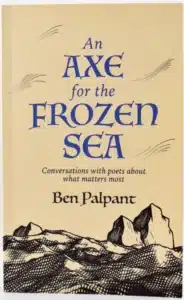
Himself a poet, Ben Palpant talks with poets about what and why they write
Occasionally, you come across a book that feels like old home week, like you’ve returned to your college alma mater and almost nothing has changed. Poet and writer Ben Palpant has written a book just like that.
The book is An Axe for the Frozen Sea: Conversations with poets about what matters most. Over the course of many months, Palpant interviewed 17 poets. He talked to them about what they write, why they write, how they view poetry (their own and others’), and generally focusing on the question most poets likely ask themselves throughout their writing careers: Why poetry?
The answers were, not surprisingly, both varied and similar. Ask 17 poets what they do and why they do it, and you’ll hear wide differences and possibly an underlying similarity.

And now I can read what they think and believe about poetry and its practice. Palpant is a good interviewer, because he’s a published poet and knows what questions to ask. His subjects either already knew him or were easily comfortable with his questions, asked in a conversational style. In fact, the book is less a series of interviews than a collection of conversations between friends.
Each interview is introduced by a statement by the poet — an observation, a memory, a side comment, or a short story. For example, Malcom Guite makes a statement about poetry: “One of the things I consciously resist and rebel against is the idea of poetry as just personal self-expression … No, I want to be the bard of the tribe, to tell the great, collective stories that bind us together — but, of course, I tell them as they happened to me.” The interview follows, and Palpant includes a poem by the poet. in Guite’s case, it’s “Maundy Thursday Lockdown,” originally entitled “Maundy Thursday, All the World Is Still.”
Add 16 more interviews, and you realize that An Axe for the Frozen Sea is a feast of poets and poetry.

Ben Palpant
Palpant has published two poetry collections, The Stranger and Sojourner Songs; the memoir A Small Cup of Light; Letters from the Mountain, a memoir on writing; the forthcoming (Aug. 1) Brightwing Tales: Mole’s Misadventures; Honey from the Lion’s Mouth, a meditation on faith; The Essential Journal for Writers; and Pepin the Magician. A graduate of Whitworth College, he lives in Washington State.
Simply put, An Axe for the Frozen Sea is a delight. It’s a doorway into how some favorite poets think and work. And it’s a reminder that poetry is far more than words displayed in a column on a page. It is a language that speaks to meaning and the essence of what it means to be human.
Photo by Torodd F. Ottestad, Creative Commons, via Flickr. Post by Glynn Young.
How to Read a Poem uses images like the mouse, the hive, the switch (from the Billy Collins poem)—to guide readers into new ways of understanding poems. Anthology included.
“I require all our incoming poetry students—in the MFA I direct—to buy and read this book.”
—Jeanetta Calhoun Mish
- Happy Thanksgiving, from Tweetspeak Poetry (and Henry Wadsworth Longfellow) - November 27, 2025
- Finding Poetry in an Anselm Kiefer Art Exhibition - November 25, 2025
- Poets and Poems: Autumn Williams and “Clouds on the Ground” - November 20, 2025


Leave a Reply